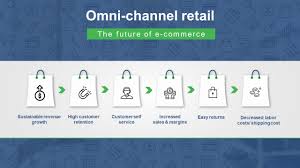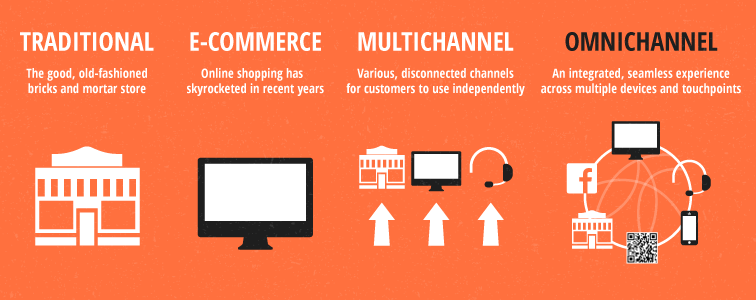Introduction
A. Definition of omnichannel retail
Omnichannel retail refers to the strategic method taken through shops to combine multiple channels seamlessly, such as brick-and-mortar stores, online structures, cell apps, social media, and extra, to create a unified and constant shopping revel in for customers. It targets to interrupt down the boundaries among on line and offline channels, offering clients with a continuing adventure from initial surfing to final purchase.
B. Brief rationalization of its importance in e-trade
Omnichannel retail has emerged as a game changer inside the e-trade industry, revolutionizing the manner agencies have interaction with customers and improving the general purchasing experience. In the era of virtual transformation, customers have emerge as acquainted with browsing and purchasing products across multiple channels. By adopting an omnichannel method, stores can meet customers’ evolving expectations, improve consumer engagement and loyalty, and power income. This blog will discover the rise of omnichannel retail and its transformative impact on the e-commerce landscape.
The Evolution of Retail
A. Traditional brick-and-mortar stores
For centuries, conventional brick-and-mortar stores have been the primary means of retail. Customers would visit physical stores to browse and purchase merchandise, counting on face-to-face interactions with sales buddies. These stores furnished a tangible purchasing experience, allowing customers to the touch, experience, and attempt out merchandise earlier than creating a purchase. However, this model had barriers in terms of convenience, as customers had been confined via working hours and region.
B. Introduction of e-trade
The creation of the internet and technological improvements introduced approximately a sizable shift within the retail panorama. The creation of e-commerce revolutionized how agencies operate and customers shop. Online structures enabled stores to show off their merchandise to a global target market, presenting convenience and accessibility 24/7. Customers could now browse and buy products from the comfort of their homes, with the introduced benefit of doorstep delivery. This marked a essential turning point in retail, increasing market attain and beginning new avenues for boom.
C. The emergence of multichannel retail
As e-commerce gained momentum, retailers started exploring more than one channels to have interaction with customers. The concept of multichannel retail emerged, in which agencies presented numerous channels which include online stores, social media platforms, and cellular apps to have interaction with customers. This method aimed to offer clients with flexibility in choosing how and in which they wanted to shop. While multichannel retail allowed clients to get right of entry to merchandise through one of a kind touchpoints, there were regularly inconsistencies within the shopping revel in throughout channels.
The boundaries of a multichannel technique paved the manner for the rise of omnichannel retail, where retailers sought to create a unbroken and integrated purchasing enjoy for customers. This shift from multichannel to omnichannel marked a transformative second inside the retail industry, blurring the limits between on-line and offline channels and setting the client at the center of the shopping journey. The following sections will delve deeper into the concept of omnichannel retail and its importance within the e-trade surroundings.
Understanding Omnichannel Retail
A. Definition and concept
Omnichannel retail, at its core, is ready presenting a unified and seamless shopping experience for clients across multiple channels. It goes beyond truely offering numerous channels for customers to have interaction with a emblem; it targets to create a cohesive and consistent revel in at some point of the patron adventure. In an omnichannel technique, clients can begin their purchasing journey on one channel, inclusive of a cellular app, hold on a internet site, and complete their buy in-store, all with none disruption or lack of facts.
B. Key functions and traits
Several key capabilities distinguish omnichannel retail from different retail techniques. First and major, it focuses on channel integration. This method that the exclusive channels, whether physical or digital, are interconnected and proportion information, ensuring a seamless transition for clients. Inventory management is likewise critical in omnichannel retail, because it allows real-time visibility of product availability across all channels. This facilitates save you situations where clients find a product on-line however discover it’s out of inventory in-shop.
Another great function of omnichannel retail is customized and centered advertising. By leveraging customer information from diverse channels, stores can supply tailor-made messages and pointers to character customers, improving their purchasing experience and growing the chance of conversion. Additionally, omnichannel retail emphasizes the significance of a consistent brand photo and messaging throughout all touchpoints, reinforcing purchaser accept as true with and loyalty.
C. Importance of seamless client enjoy
One of the primary drivers of the upward push of omnichannel retail is the growing call for for a continuing consumer revel in. Customers nowadays count on convenience, flexibility, and personalization all through their purchasing journey. They need the potential to analyze merchandise on line, try them in-save, and make their purchase on their preferred channel. An omnichannel technique caters to those expectations by means of eliminating friction factors and providing a cohesive revel in across channels.
A seamless patron enjoy ends in several benefits for both clients and retailers. Customers experience comfort, as they could select the maximum convenient channel for every degree of their journey. They additionally advantage from constant data, which include product details, pricing, and promotions, irrespective of the channel they use. For retailers, a seamless purchaser revel in translates into extended patron satisfaction, higher engagement, and advanced conversion fees. It additionally fosters patron loyalty and advocacy, as clients are much more likely to return to a logo that always can provide a superb and problem-loose experience.
The Impact of Omnichannel Retail on E-commerce
A. Enhanced patron revel in
Omnichannel retail has extensively stronger the customer enjoy within the e-commerce landscape. By seamlessly integrating numerous channels, outlets can provide customers with a regular and convenient purchasing adventure. Customers can effects switch between online and offline channels, having access to product records, evaluations, and inventory availability in real-time. This comfort empowers clients to make knowledgeable purchasing selections, main to higher client delight and a high-quality emblem belief.
B. Increased purchaser engagement
Omnichannel retail has revolutionized patron engagement strategies for e-trade agencies. With a couple of touchpoints to be had, retailers can engage with clients throughout their journey, shooting their interest and fostering deeper connections. By leveraging channels like social media, cellular apps, and e-mail advertising, outlets can supply targeted and personalized content to have interaction clients and build brand loyalty. Additionally, functions like stay chat and customized tips similarly beautify the level of customer engagement and inspire repeat visits and purchases.
C. Improved consumer loyalty and retention
One of the sizable benefits of omnichannel retail in e-trade is the nice effect on customer loyalty and retention. By turning in a seamless and personalised enjoy, shops can cultivate long-term relationships with clients. Consistency throughout channels builds trust and loyalty, as customers feel valued and understood. Furthermore, capabilities like loyalty programs and rewards may be seamlessly included throughout channels, encouraging repeat purchases and fostering client loyalty. The capacity to provide a cohesive experience, blended with customized offers and exceptional service, helps e-trade organizations stand out in a aggressive market and preserve their precious clients.
Data-pushed insights and personalised advertising
Omnichannel retail generates a wealth of customer records, supplying e-commerce corporations valuable insights into customer behavior, choices, and purchasing patterns. By leveraging this information, stores can create targeted and customized advertising campaigns. They can supply applicable hints, gives, and promotions to clients based totally on their browsing and purchase history. Personalized marketing now not only improves the client revel in however additionally increases the chances of conversion and consumer pride. The capacity to track and analyze patron records throughout channels permits stores to refine their advertising techniques and optimize their offerings to meet clients’ evolving needs.
In the next phase, we will explore the realistic elements of imposing omnichannel strategies, consisting of integration, stock management, and cross-channel verbal exchange.
Implementing Omnichannel Strategies
A. Integration of on-line and offline channels
Successful implementation of omnichannel strategies requires the seamless integration of on line and offline channels. This integration allows clients to have a constant experience across distinctive touchpoints. Retailers need to make sure that statistics, consisting of product availability, pricing, and promotions, is synchronized across all channels in actual-time. This allows customers to begin their adventure online, go to a physical store for in addition exploration, and entire their purchase on any channel they pick. Integration also extends to client facts, ensuring that patron profiles and alternatives are on hand across channels for personalised interactions.
B. Unified stock control
A crucial aspect of omnichannel retail is unified inventory management. Retailers want to have a centralized machine that gives actual-time visibility of inventory across all channels. This enables correct stock availability information and stops conditions in which clients come upon out-of-inventory items after beginning their buying adventure. With unified stock management, stores can fulfill client orders effectively, whether they’re located on-line, in-keep, or thru different channels. This facilitates keep away from inventory discrepancies and complements the overall purchaser experience with the aid of minimizing delays and order cancellations.
C. Seamless move-channel verbal exchange
Effective go-channel communication is important for a cohesive omnichannel revel in. Customers should be able to transition among channels seamlessly with none lack of information or disruption. For instance, if a purchaser provides gadgets to their on line buying cart, they ought to be able to get right of entry to and adjust the cart on different channels, such as a cell app or in-keep. Similarly, customer service inquiries and interactions need to be regular and synchronized throughout channels. Seamless cross-channel communique ensures that clients receive consistent and well timed aid, improving their overall pleasure.
D. Leveraging generation for a cohesive enjoy
Technology plays a crucial position in allowing a cohesive omnichannel enjoy. Retailers can leverage diverse gear and technology to facilitate integration, records management, and personalized interactions. Customer dating management (CRM) structures, for example, assist outlets consolidate and analyze consumer statistics, taking into consideration centered marketing campaigns. Mobile apps and responsive web sites provide a unbroken browsing experience across gadgets. Additionally, emerging technologies inclusive of artificial intelligence (AI) and gadget getting to know can be applied to customise hints and automate techniques. By leveraging era effectively, retailers can create a cohesive and user-friendly experience that aligns with consumer expectancies in the virtual age.
In the following phase, we can explore the demanding situations and concerns associated with imposing omnichannel techniques and provide insights on overcoming them.
Challenges and Considerations
A. Infrastructure and logistics
Implementing omnichannel strategies requires sturdy infrastructure and green logistics to guide seamless integration across channels. Retailers want to ensure that their systems, inclusive of inventory management, order fulfillment, and client records management, are able to dealing with the expanded complexity of omnichannel operations. This may additionally contain making an investment in superior technology, upgrading IT infrastructure, and streamlining logistics procedures to allow timely and accurate order achievement throughout more than one channels.
B. Data integration and control
Omnichannel retail generates sizable quantities of records from diverse touchpoints, consisting of on-line systems, physical stores, cellular apps, and social media. Retailers face the assignment of integrating and coping with this facts successfully. Data silos can prevent the capability to advantage a holistic view of customers and deliver personalized reports. It is critical to establish strong data integration methods and put in force facts management techniques that make sure records accuracy, security, and compliance. Retailers need to additionally comply with privacy regulations and advantage customers’ agree with with the aid of being transparent approximately data series and utilization.
C. Staff training and talent development
The a hit implementation of omnichannel strategies calls for a nicely-skilled and professional personnel. Retail personnel want to be prepared with the information and competencies to navigate and assist clients throughout various channels. This includes understanding the technical elements of on line structures, mobile apps, and different digital tools. Providing complete education applications and ongoing ability development opportunities is important to empower personnel to supply a unbroken omnichannel experience. Additionally, cultivating a client-centric way of life within the organisation is crucial for employees to prioritize and exceed purchaser expectations.
D. Cybersecurity and privateness worries
As omnichannel retail relies heavily on virtual structures and consumer records, cybersecurity and privateness issues come to be outstanding. Retailers have to prioritize the safety of customer statistics and put in force robust cybersecurity measures to protect in opposition to facts breaches and unauthorized get admission to. This includes implementing encryption, steady price gateways, and regular security audits. Retailers additionally need to deal with privacy worries and ensure compliance with statistics protection rules. Transparent communication with clients concerning information coping with practices and obtaining consent for data utilization are important for building agree with and preserving client self belief.
In the next section, we will discover a hit examples of omnichannel retail and draw insights from their techniques and practices.
Successful Examples of Omnichannel Retail
A. Case observe 1: Retailer X’s omnichannel approach
Retailer X serves as an terrific example of a successful omnichannel approach. They have seamlessly included their online and offline channels to provide a cohesive buying revel in. Customers can browse products, take a look at stock, and make purchases through their user-friendly internet site or cell app. Additionally, Retailer X offers convenient in-shop pickup and returns, permitting clients to have the ability of choosing the most suitable channel for their wishes. By leveraging consumer records, Retailer X offers personalized recommendations and promotions, ensuring a tailor-made experience across channels. Their consciousness on handing over incredible customer service has led to extended client pleasure and loyalty.
B. Case examine 2: E-trade platform Y’s seamless integration
E-commerce platform Y has executed seamless integration across multiple channels, setting a benchmark for omnichannel retail. They have evolved a centralized inventory control gadget that provides real-time visibility across all channels. This permits accurate stock availability information and forestalls customer unhappiness because of out-of-inventory objects. E-commerce platform Y also prioritizes pass-channel conversation, making sure that customers can seamlessly transition between channels with none disruptions. By leveraging generation, consisting of AI-driven customized guidelines and chatbots, they’ve stronger consumer engagement and delight. Their commitment to statistics security and privateness has mounted trust amongst clients, contributing to their success.
C. Lessons discovered and excellent practices
These a hit examples of omnichannel retail provide precious training and fine practices for companies intending to put into effect an effective omnichannel strategy. First and primary, integration is key. By seamlessly integrating on line and offline channels, companies can provide a steady and convenient revel in to customers. Unified inventory control ensures real-time visibility, stopping stock discrepancies and permitting green order fulfillment. Cross-channel communication need to be seamless, permitting clients to transition effortlessly and get right of entry to regular information. Leveraging era, inclusive of AI and personalised marketing, complements client engagement and pleasure. Lastly, prioritizing cybersecurity and privacy builds consider with customers and safeguards their sensitive records.
In the very last segment, we are able to explore destiny traits and possibilities in omnichannel retail, as well as provide concluding mind at the effect of omnichannel retail at the e-commerce enterprise.
Future Trends and Opportunities
A. The function of emerging technology (AI, IoT, AR/VR)
The destiny of omnichannel retail holds mammoth capability with the combination of rising technologies. Artificial Intelligence (AI) can further decorate customized purchaser stories by reading full-size amounts of information and presenting actual-time guidelines. Internet of Things (IoT) devices can permit seamless connectivity between bodily products and digital platforms, growing interactive and personalised reports. Augmented Reality (AR) and Virtual Reality (VR) technologies provide the opportunity to bridge the gap among online and offline purchasing, allowing customers to honestly attempt on merchandise or visualize them of their personal spaces. Embracing these technology can release new dimensions of engagement and consumer satisfaction inside the omnichannel retail landscape.
B. Voice trade and smart assistants
Voice commerce is a growing fashion this is set to reshape the way clients have interaction with manufacturers. The upward push of clever assistants like Amazon’s Alexa, Google Assistant, and Apple’s Siri has elevated voice-primarily based purchasing stories. Customers could make purchases, reorder merchandise, and are seeking for product hints through voice commands. Integrating voice trade into omnichannel strategies opens up new possibilities for outlets to interact with customers and provide frictionless shopping reports. Voice trade additionally provides a unique road for personalized marketing and brand engagement, as smart assistants grow to be extra integrated into clients’ daily lives.
C. Social media integration and influencer marketing
Social media has grow to be an critical a part of customers’ lives and performs a vast function of their buy selections. Integrating social media systems into omnichannel techniques affords a mess of opportunities. Retailers can leverage social media to exhibit products, run targeted advert campaigns, and engage with customers in actual-time. Influencer marketing, where influential individuals sell products and types on social media, has gained traction and is proving to be a powerful tool for accomplishing and influencing clients. By partnering with applicable influencers, retailers can faucet into their fans’ accept as true with and reach a much broader target audience, riding emblem consciousness and income.

In end, the upward thrust of omnichannel retail has converted the e-trade industry, presenting customers a seamless and integrated buying revel in across more than one channels. By know-how the idea of omnichannel retail and its importance, businesses can decorate patron reviews, boom engagement, foster loyalty, and leverage statistics-driven insights for personalised advertising and marketing. Implementing omnichannel techniques calls for careful issues along with infrastructure, records integration, body of workers training, and cybersecurity. By analyzing successful examples and embracing destiny developments like emerging technology, voice commerce, and social media integration, agencies can stay beforehand of the curve and capitalize at the infinite possibilities that omnichannel retail presents within the ever-evolving e-trade panorama.
Conclusion
A. Recap of the rise of omnichannel retail
Omnichannel retail has emerged as a sport changer within the e-trade enterprise, revolutionizing the way corporations engage with clients across a couple of channels. It has advanced from traditional brick-and-mortar stores to the advent of e-trade and the emergence of multichannel retail. Today, omnichannel retail specializes in presenting a seamless and included client enjoy, no matter the channel customers pick out to interact with.
B. Summary of advantages and demanding situations
The benefits of omnichannel retail are severa. It enhances the consumer enjoy by presenting comfort, personalized interactions, and consistent messaging. It will increase patron engagement and loyalty, using repeat purchases and logo advocacy. Omnichannel retail additionally offers statistics-driven insights, allowing businesses to deliver centered advertising and marketing campaigns and improve choice-making. However, enforcing omnichannel techniques comes with challenges, together with infrastructure and logistics, statistics integration and control, personnel training, and cybersecurity worries. Overcoming those challenges calls for careful planning and funding in technology and body of workers improvement.
C. Final thoughts at the future of e-trade and omnichannel retail
The destiny of e-trade is undoubtedly intertwined with the continuing growth and innovation of omnichannel retail. As technology advances and customer expectations evolve, organizations must adapt to live competitive. The role of rising technologies, such as AI, IoT, and AR/VR, will play a important position in shaping the future of omnichannel retail. Voice trade and clever assistants will rework how clients interact with brands, while social media integration and influencer advertising will continue to effect buy decisions. The key to achievement lies in embracing these traits, even as also prioritizing consumer-centric strategies, seamless integration, and facts-driven personalization.
In conclusion, omnichannel retail has redefined the e-trade landscape, imparting organizations extraordinary opportunities to connect to customers in significant approaches. By know-how the idea, imposing powerful strategies, and addressing challenges, organizations can liberate the overall capacity of omnichannel retail. The destiny holds extremely good promise for folks that include the electricity of seamless integration, rising technology, and customer-centric procedures, ensuring a thriving future for e-trade and a simply transformative shopping enjoy for clients.


